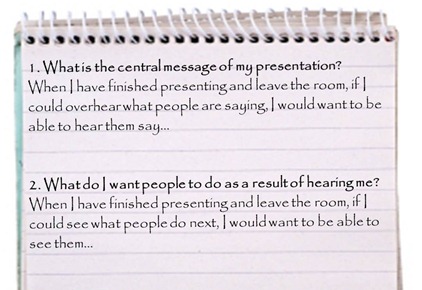Pocketblog has gone back to basics. This is part of an extended management course.
There are more than enough blogs out there that will promise that they can teach you to present powerfully, magically, persuasively and with impact. Perhaps they can.
But, to me, these claims seem to be somewhat hyperbolic in the context of a short article – or even series of articles – that most readers will scan for nuggets and hope to put them into practice all in one go.
Let’s be more circumspect. For most managers who need to present occasionally, their number one and two concerns are to get their message across effectively, and feel good about doing it. So print off this set of exercises, and next time you need to do a presentation, follow the exercises one at a time.
Exercise 1: Prepare your Presentation
Here are the two most important questions you need to answer before you do anything else. Write them down and then complete the sentences.
1. What is the central message of your presentation?
When I have finished presenting and leave the room, if I could overhear what people are saying, I would want to be able to hear them say…
2. What do you want people to do as a result of hearing you?
When I have finished presenting and leave the room, if I could see what people do next, I would want to be able to see them…
Everything that goes into your presentation must underscore your central message and work towards justifying your call to action. Only when you have the answers to those two questions clear in your mind should you start to work on the content, and then the introduction, to your presentation.
Exercise 2: Rehearse your Presentation
This is how you find out what works and what does not. It is how you lock the essential messages and neat turns of phrase into your memory. It is how you start to feel confident with your performance.
Rehearse once, informally, to get the measure of what you have prepared. Rehearse again to feel its flow. Rehearse again to feel comfortable with the material. Rehearse in front of a colleague to get their most essential feedback. Rehearse again to incorporate it. Rehearse again to lock in pauses, drama and rhythm. Rehearse one last time to feel in complete control.
Exercise 3: Get there Early
Arrive wherever you need to be in good time to freshen up, check your appearance in the bathroom mirror, and set up any technical logistics. Circumstances will vary considerably, but aim to be good and ready to start well before you are likely to meet the first members of your audience. That way, you can turn your full attention to them without having to think about the technicalities of your presentation. If your presentation is virtual, these same rules apply.
Exercise 4: Own your Platform
When you are on your platform, think of it as yours. Take pauses. Look at your audience. Use the space. Be natural and think of this as a conversation with each person in the audience. You can be yourself and, while I don’t encourage ums and ers, they are a natural part of your speech, so don’t worry about them unless you have previously had it highlighted by an objective observer. A few here or there will not matter a jot. Neither will that little detail or great quote you planned to add in matter – even if you forget them. Only one person in the room will know you missed it. Everyone else will be focusing on what you did say.



